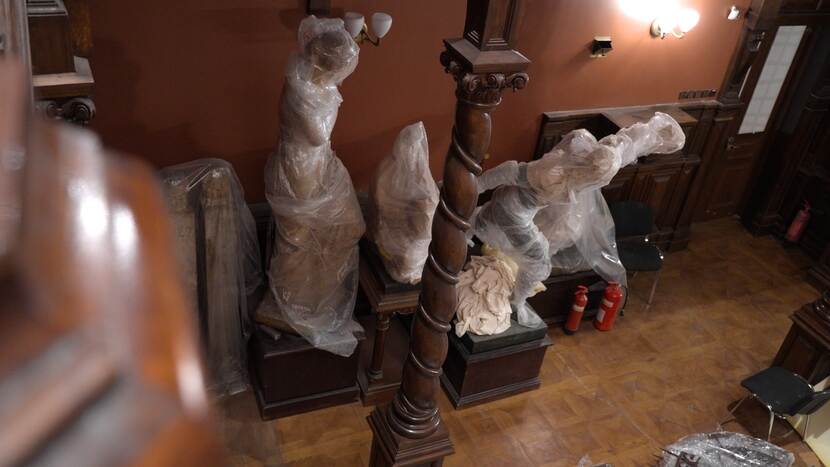UNESCO Hague Convention: protecting cultural property at times of conflict
Weblogs
The Netherlands, together with other countries, wants to ensure that cultural heritage is not lost through armed conflict. That’s why it is hosting a conference in the Peace Palace from 13 to 15 May that will build on the UNESCO Hague Convention for the Protection of Cultural Property in the event of Armed Conflict. The convention will have its 70th anniversary this year. The many conflicts worldwide and war in Europe make the convention’s aim more topical than ever.
 Enlarge image Het Haags Verdrag van UNESCO voor de bescherming van cultureel erfgoed bij gewapend conflict werd in 1954 getekend in Den Haag.
Enlarge image Het Haags Verdrag van UNESCO voor de bescherming van cultureel erfgoed bij gewapend conflict werd in 1954 getekend in Den Haag.The protection of art, cultural heritage and architecture during war, now and in the future, is a matter of the highest priority for UNESCO and its member states. At present, countless armed conflicts are raging around the world, and Russia has brought war back to the European continent. In recent decades, too, conflicts and looting have led to cultural heritage being severely damaged or completely destroyed, for example in the Balkans. The destruction is often targeted.
Russia’s war of aggression against Ukraine is a current example of an armed conflict in which cultural objects are being deliberately attacked. Russia does this with the aim of eradicating Ukrainian culture and identity.
Targeted drone attack
Andryi Hrynchuk is honorary Dutch consul in the Ukrainian city of Lviv, and has witnessed the destruction of cultural heritage by Russia at close hand. The Roman Shukhevych House Museum, for example, was destroyed earlier this year in a targeted drone attack. Andryi explains: ‘Roman Shukhevych was the military leader of the Ukrainian Insurgent Army that fought Soviet troops for many years after the end of the Second World War. He died in 1950 on the spot where the museum stood. It was originally just a house, but after Ukraine declared independence from the Soviet Union in 1991, it became a museum. Russia specifically chose to destroy this building, decades after Shukhevych fought against its army.’
Andryi continues: ‘I heard the Russian President Putin say in a speech that he attacked Ukraine on historic grounds. That, historically speaking, parts of our country are really part of Russia. Meanwhile Russia is busy destroying cultural remnants of our actual history, purely so they can replace it with their own version.’
Khanenko museum
Staff of the Khanenko Museum in Kyiv also know all too well how Ukrainian culture has come under pressure in many parts of the country since 2022, and in regions such as Crimea as far back as 2014. ‘Before the Russian invasion we used to have a very varied art collection, which started out as the private collection of Bohdan and Varvara Khanenko,’ Marharyta Stafiichuk, who works at the museum, says. ‘The collection included Byzantine art, Renaissance paintings and also work by Dutch artists such as Peter Paul Rubens and Jan Verbruggen.
‘On 22 February 2022, the day of the invasion, everything changed,’ she goes on. ‘We immediately had to think about how to protect our collection, and we packed up all the paintings we could and took them to a safe place. It’s just as well, because on 10 October 2022, a Russian rocket struck near the museum, considerably damaging both the outside and inside of the building.’
Marharyta and her colleagues intend to do their utmost to safeguard the museum during the war, she says with fighting spirit. ‘Cultural preservation is incredibly important. At an emotional level, it’s not to be compared with the military violence, the loss of human life and the fact that so many people have lost their homes, but cultural preservation is about Ukraine’s collective memory. If that is lost, what are we fighting for?
‘On top of that,’ she concludes, ‘museums can offer hope during times of conflict. We see that the people who come here find solace in the enjoyment of art. That’s a key role for museums, and it highlights the importance of cultural preservation. At the moment we’re mounting temporary exhibitions in the museum, but we hope that the war will end soon, so that we can display its proper collection again.’
70th anniversary of UNESCO Hague Convention
During various conferences in 2024 UNESCO will flesh out parts of the Convention for the Protection of Cultural Property. The conference in The Hague marks the official start of the convention’s 70th anniversary, it having been signed in the Peace Palace in The Hague in 1954.
Read more about the UNESCO conference in The Hague.
Watch the photos of the UNESCO-conference on Flickr.


